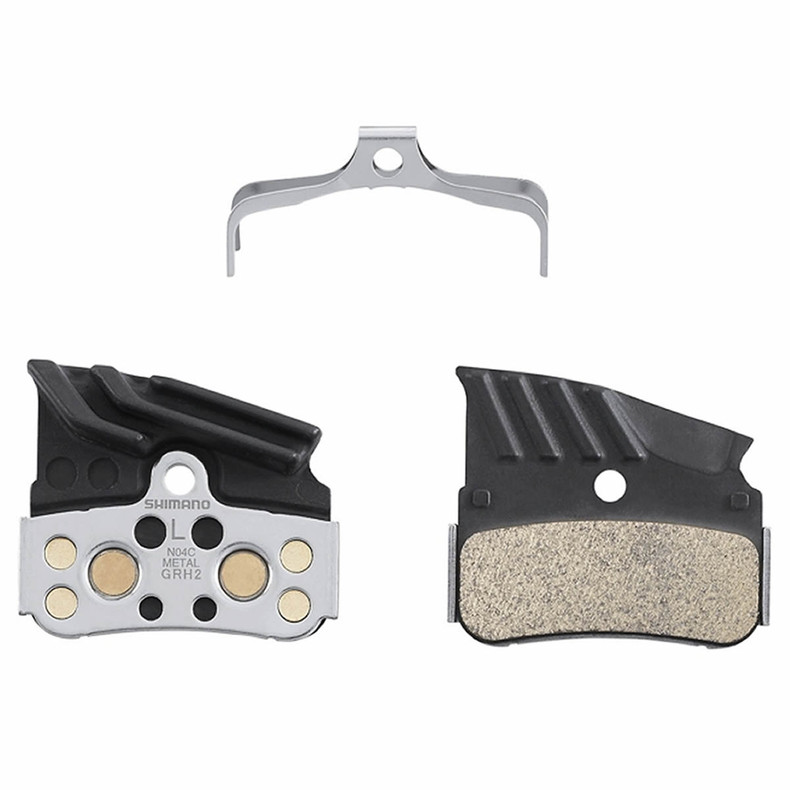Naming Convention
Figuring out what brake pads you need can be a confusing proposition. Although Shimano has a seemingly confusing naming convention for their brake pads (H03C-MF), their is some pretty sound logic behind it once you know what all the letters and numbers stand for.

Series
All Shimano disc brake pad names start with what series they are part of. The series indicates the shape of the pad and what disc brake caliper it can fit into. This is where is gets a bit tricky, how do you find out what series of disc brake pads are compatible with your disc brake caliper? I've put together useful table to help.
| Image | Series | Brake Caliper |
|---|---|---|
 |
B | BR-C501, BR-M575, BR-M525, BR-M495, BR-M486, BR-M485, BR-M475, BR-M465, BR-M447, BR-M446, BR-M445, BR-M416, BR-M415, BR-M4050, BR-M3050, BR-M395, BR-M375, BR-M365, BR-M355, BR-M315, BR-T675, BR-T615, BR-TX805, BR-MT500, BR-MT400, BR-MT200, BR-UR300 |
 |
D | BR-M8120, BR-M7120, BR-M8020, BR-M820, BR-M810, BR-M640, BR-MT520, BR-MT420 |
 |
G | BR-M9020, BR-M9000, BR-M8100, BR-M8000, BR-M7100, BR-M7000, BR-M6100, BR-M6000, BR-M987, BR-M985, BR-M785, BR-M675, BR-M666, BR-M615, BR-S700, BR-CX77, BR-CX75, BR-RS785, BR-R785, BR-R517, BR-R515, BR-R317, BR-R315 |
 |
H | BR-M8020, BR-M820, BR-M640 |
 |
J | BR-M9020, BR-M9000, BR-M8000, BR-M987, BR-M985, BR-RS785, BR-R785, BR-M785, BR-M765, BR-M666, BR-M615, BR-S700 |
 |
K | BR-M9110, BR-M9100, BR-M8110, BR-R9270, BR-R9170, BR-R8170, BR-R8070, BR-R7070, BR-4770, BR-RS805, BR-RS505, BR-RS405, BR-RS305, BR-U5000, BR-RX810, BR-RX400 |
 |
L | BR-M8110, BR-M7110, BR-R9270, BR-R8170, BR-R9170, BR-R8070, BR-R7070, BR-R4770, BR-RS805, BR-RS505, BR-RS405, BR-RS305, BR-U5000, BR-RX810, BR-RX400 |
 |
M | BR-M975, BR-M966, BR-M965, BR-M800, BR-M776, BR-M775, BR-M765, BR-M665, BR-M601, BR-M596, BR-M595, BR-M585, BR-M545, BR-M535, BR-R505, BR-S501, BR-S500, BR-T665, BR-T605 |
 |
N | BR-M9120, BR-M8120, BR-M7120 |
 |
P | BR-M9220, BR-M9200 |
Generation
The two generation numbers (03) simply refer to the current version of the pads. Sometimes there can be running changes during production so there may be a need to increment the generation numbers to indicate there has been a change. These numbers should not affect which disc brake pads are compatible with your Shimano disc brakes, that is up to the Series designation.
Backplate Material
Aluminium
Aluminium is more conductive than steel so heat that is generated from the pads will transfer through the backplate into the brake caliper pistons and oil more easily. As oil heats up it expands which will increase the pressure in the brake system resulting in a stiff feeling brake lever. The main benefit to using brake pads with aluminium backplates is that they are lighter than steel.
Combination
Shimano brake pads with cooling fins have a combination of steel and aluminium. The fins are made of aluminium to help conduct heat away from the brake system while the backplate is steel to help insulate the pistons and oil from the hot pads.
Steel
Steel is less conductive than aluminium so heat that is generated from the pads will take longer to transfer through the backplate into the brake caliper pistons and oil. This results in a more consistent feeling brake because the oil is not heating up as quickly. Steel is also heavier than aluminium.
Titatium
Titanium is less conductive than aluminium and steel so it makes for a great insulator to protect the brake caliper pistons and oil from heating up as quickly. The heat needs to go somewhere though so you can expect the disc brake rotor to get hotter.
Pad Material
Metallic
Also known as sintered, metallic pads contain a high percentage of iron and steel which are bonded together with a resin. The high metal concentration make them more heat tollerant and longer lasting which also means that they'll wear down steel disc brake rotors faster than resin pads. Metallic pads provide more stopping power, are slightly noisier and perform much better in wet conditions compared to resin pads.

Resin
Also known as organic, resin pads contain an assortment of fibers and a small amount of metal which are bonded together with a resin. The high fiber concentration makes them less heat tollerant and faster wearing which also means that they won't wear down steel disc brake rotors as quickly as metallic pads. Resin pads provide less stopping power, are quieter than metallic pads and don't perform very well in wet conditions.

Backplate Type
Finned
The fins on disc brake pads act as a heatsink to conduct heat away from the brake system where it can be disipated in the air as you ride along. Finned brake pads are able to operate at a much lower temperature so your brakes should feel more consistent as they aren't transfering as much heat through to the disc brake caliper pistons and oil. Shimano brakes use mineral oil which has a boiling temperature of approximately 218°C which means you could boil your brake fluid under heavy breaking situations. In comparison, DOT 5.1 has a higher boiling point of 260°C so brake systems using DOT 5.1 don't need to worry about the effects of high temperatures as much.

Non-finned
Commonly known as "standard" brake pads, they have no cooling fins to help disipate heat so they will run hotter which will negatively impact your brake system by transfering more heat to the disc brake caliper pistons and oil.


